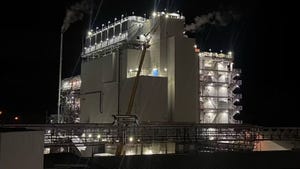Bottle Wars: Video showcases plastic milk bottles dropped out of helicopter
On the PlasticsToday twitter page, a follower had sent us a link highlighting a "plastic packaging innovation."Naturally, I was curious so I clicked on the link that sent me to a YouTube page to the video entitled, "Bottle Wars." Apparently a battle of epic 'plastic' proportions is brewing in the UK.
October 15, 2012
On the PlasticsToday twitter page, a follower had sent us a link highlighting a "plastic packaging innovation."
Naturally, I was curious so I clicked on the link that sent me to a YouTube page to the video entitled, "Bottle Wars." Apparently a battle of epic 'plastic' proportions is brewing in the UK.
The video was created by Nampak Plastics Europe, a manufacturer of high-density polyethylene (HDPE) milk and juice bottles, primarily for the dairy industry. Nampak currently produces about two billion plastic milk bottles annually. The company's fully recyclable Infini HDPE bottles, contains 15% recycled material and can achieve up to 25% lightweighting compared to standard milk bottles.
The film, which is accompanied by the soundtrack of Richard Wagner's Ride of the Valkyries, compares the strength of Nampak's Infini bottles to that of its main competitor, Alpla.
The video shows 25 Infini bottles and 25 of Alpla's rival bottle being dropped from a helicopter at a height of 300 feet. With parachutes attached, blue for Nampak and red for Alpla, the bottles hit the ground at the same speed as they would in the industry-standard 0.9m-drop test performed in laboratory conditions.
While the Infini bottles remain intact and bounce on the runway, Alpla's design split and empty milk over the tarmac.
I have to say Nampak went great lengths to showcase the strength of its HDPE bottles. One of my first questions to Jamie Tinsley, commercial director for Nampak Plastics, was about the investment to shoot the video.
While he couldn't divulge details regarding the cost, he did point out, "it didn't cost anywhere near the amount that people seem to think it did." All of the footage was captured in a single day.
"The 'Bottle Wars' video was a direct response to some incorrect information that Alpla had circulated across the market, making false claims about Infini's robustness compared to their own inferior design," Tinsley said. "Our film makes it blatantly clear which bottle is stronger."
If you watch the video, you saw that the Alpla crashed and burned while the Infini bottles survived. Obviously since Nampak is behind this video, it wasn't hard to predict that conclusion.
Reading some of the comments about the YouTube video, one said, "I'm 300 ft tall, these'll come in so handy whenever I drop the milk! Thanks, Infinibottle!"
Another user stated, "Absolutely brilliant, and I'm not surprised to see the Alpla bottles fail. The ones in our local Tesco are flimsy and frequently distorted. Using recycled HDPE material places additional demands on lightweight bottles and my gut feeling is that the Infini bottle will be capable of accepting much higher percentages of rHDPE than the Alpla bottle."
Lightweight bottles here to stay
This video comes a time where the issue of the lightweight bottle is a significant battleground for the future of the industry. Waste reduction targets set for retailers under the Courtauld Commitment and the Dairy Roadmap states that milk packaging must use 30% of rHDPE by 2015 and 50% rHDPE by 2020.
"It's a key time for the British milk industry, a next-generation, eco-friendly bottle needs to be chosen and there are predominantly two competing products in the market: our own Infini bottle and one from a competitor, Alpla," Tinsley said.
predominantly two competing products in the market: our own Infini bottle and one from a competitor, Alpla," Tinsley said.
Alpla recently announced it will produce its lightweight HDPE bottles for Arla Foods, which will deliver a weight savings in excess of 20% compared to Arla's current milk bottles. Alpla is also targeting an industry first recycled HDPE material content of 50% in all bottles for Arla Foods.
The Infini bottle was officially launched in 2012 after four years of collaborative efforts from the Nampak team and following extensive trials, tests and rigorous market research.
Tinsley said the design team developed an innovative manufacturing approach, which Nampak has successfully patented, by enabling the overall bottle, as it is being blowmolded within the mold, for the plastic not be stretched as far into all four corners, as it is with the standard design.
Other features such as the area around the neck of the bottle and the overall multi-sided bottle walls make for a far stronger bottle even at these vastly reduced weights, he said.
The company is close to having 30 million bottles sold now into the UK dairy market. Tinsley said the plan is to have Infini rolled out across its entire business and they are in the process of converting machines to support this initiative. Throughout 2013, the main bulk of the equipment will be phased over to Infini.
Blowmolding processing trials are already underway to determine the feasibility of incorporating 30% and 50% rHDPE in the company's milk bottles.
License opportunities do exist for the Infini design and Tinsley said they are "keen" to explore as many opportunities as they can from around the world.
"The approaches we already had for the Infini design are not limited to the milk industry either, it includes detergents, juice, fabric softeners and many other items currently packaged in plastic bottles," Tinsley said. "The new Infini design has created quite a stir."
Does that mean detergents wars are in the near future?
About the Author(s)
You May Also Like


